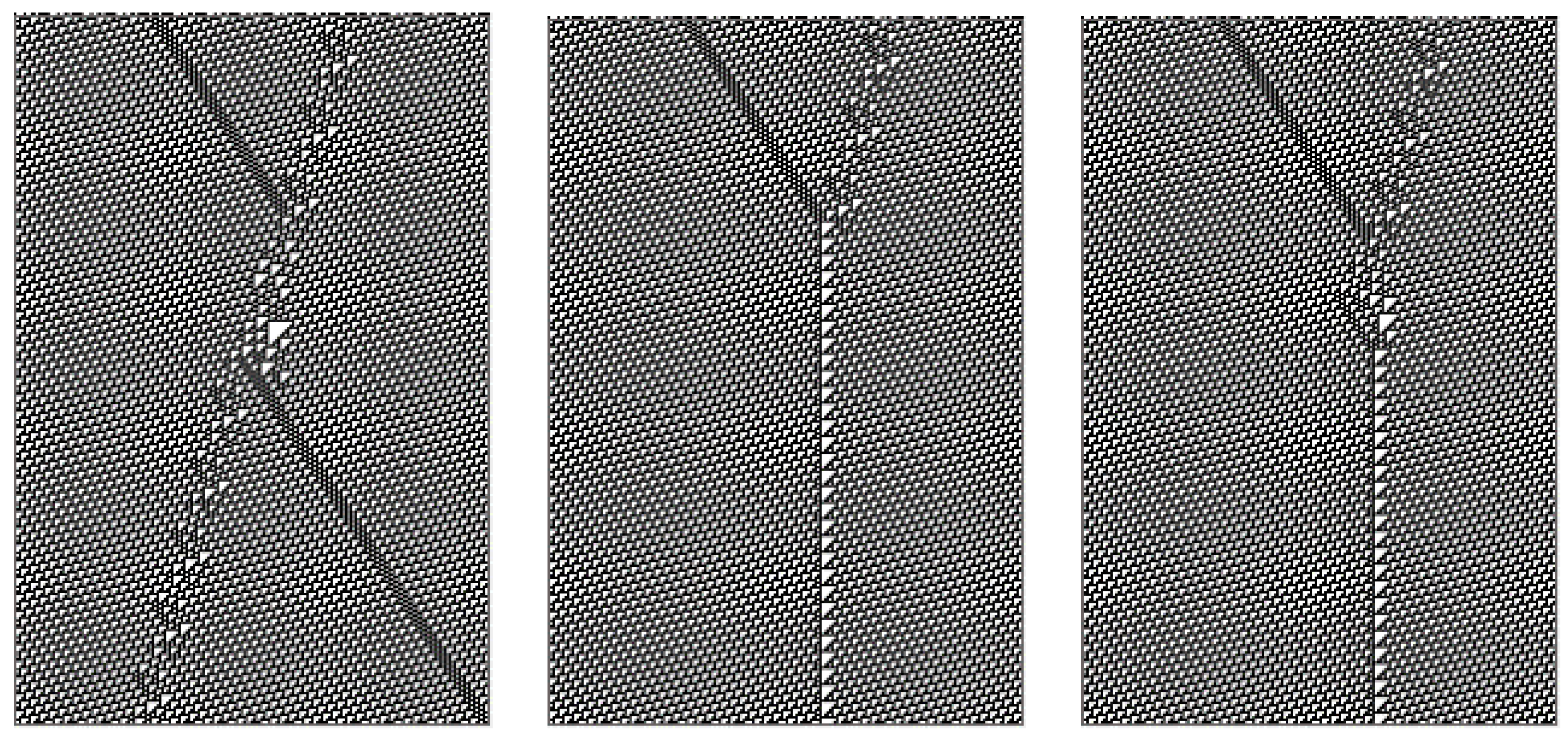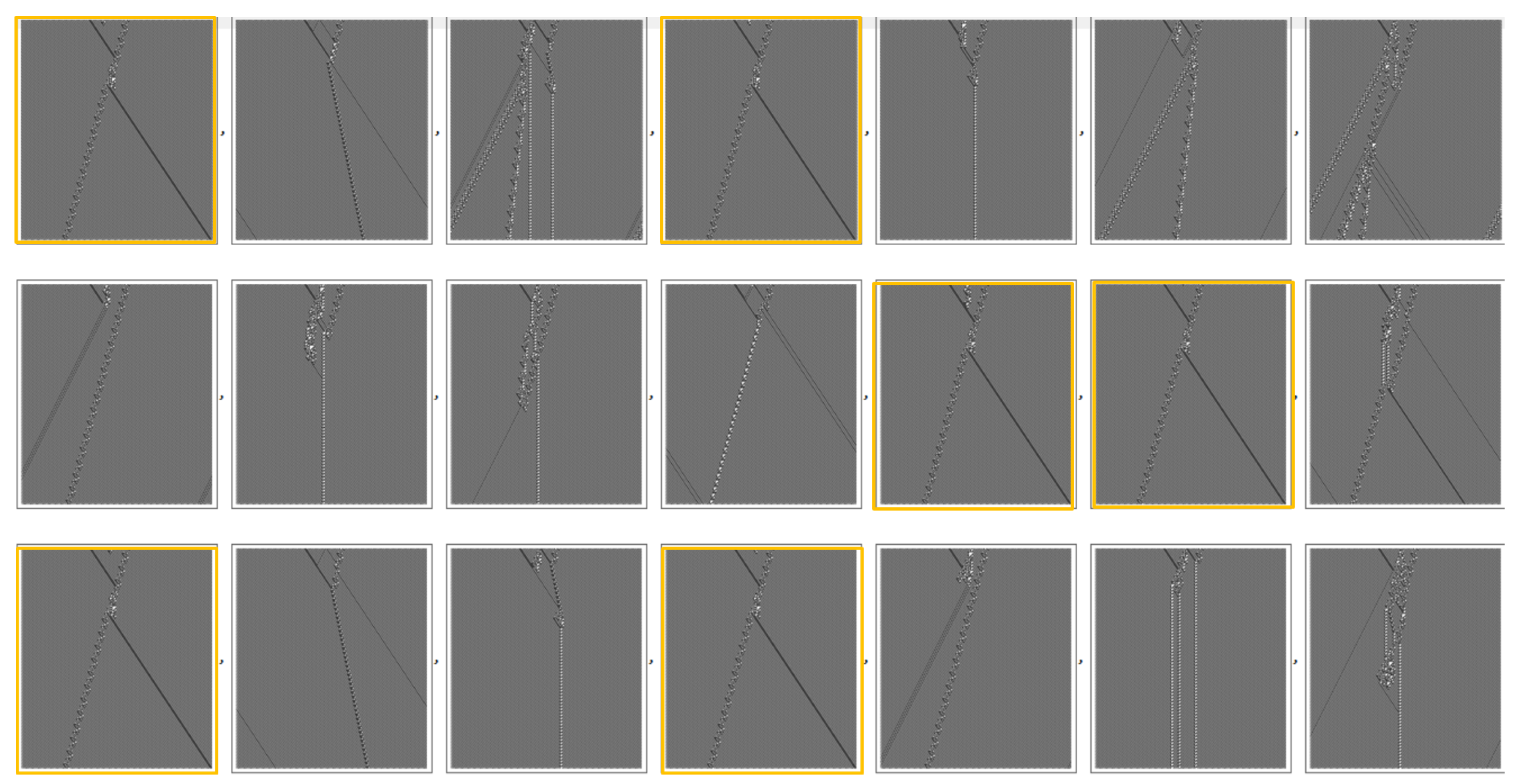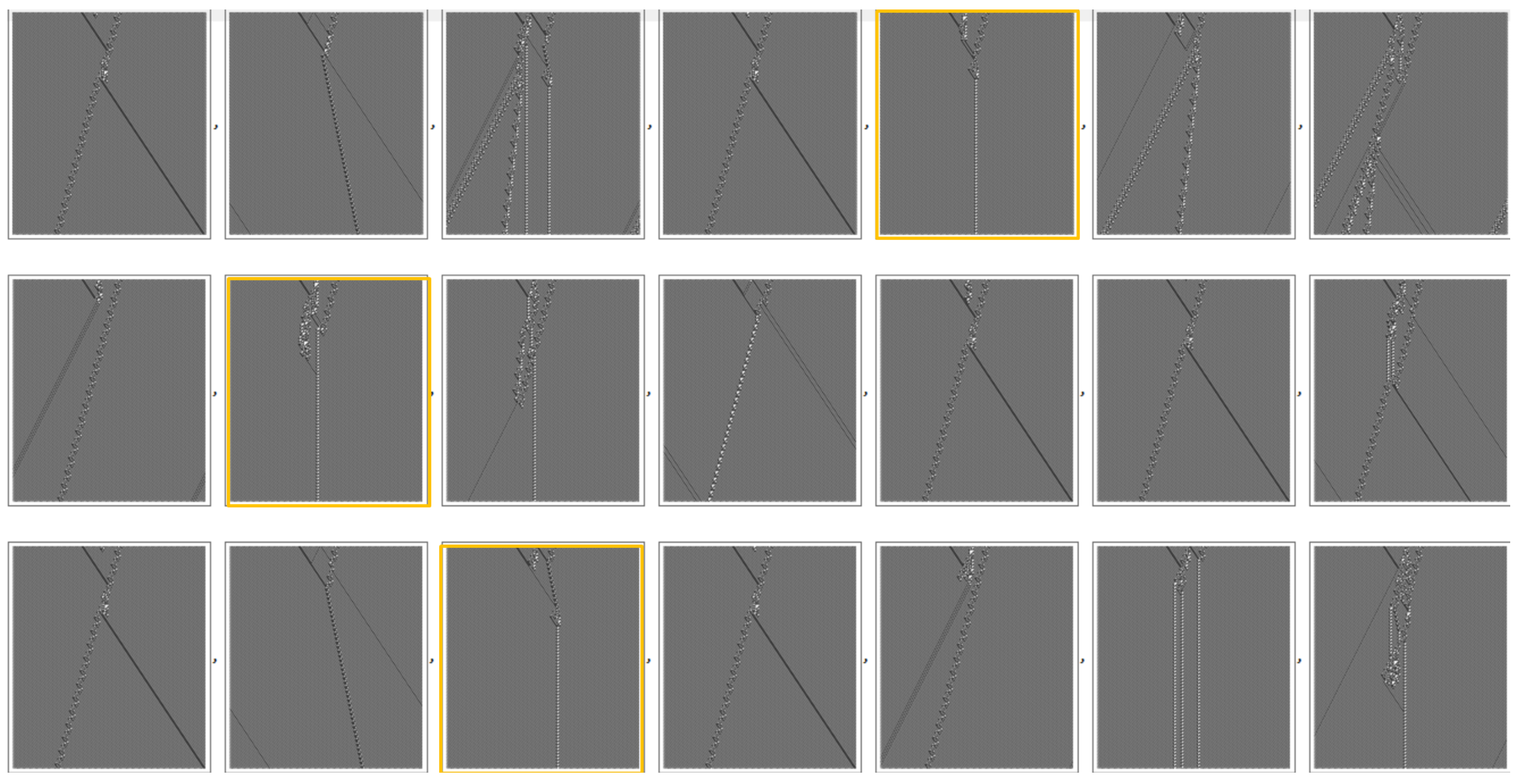Toy Models of Top Down Causation
Abstract
1. Introduction
The reductionist hypothesis may still be a topic for controversy among philosophers, but among the great majority of active scientists I think it is accepted without question. The workings of our minds and bodies, and of all the animate or inanimate matter of which we have any detailed knowledge, are assumed to be controlled by the same set of fundamental laws, which except under certain extreme conditions we feel we know pretty well. [1]
2. Cellular Automaton 110
3. Probabilistic Models Based on Cellular Automata and Top-Down Causation
3.1. A Simple Probabilistic Model
3.2. Incorporating Top–Down Causation
3.3. Compatibility with Standard Temporal and Minkowski Causation
4. Discussion
4.1. Panprotopsychist Models of Consciousness
4.2. Quantum Theory, Gravity and Classical Physics
Funding
Acknowledgments
Conflicts of Interest
References
- Anderson, P.W. More is different. Science 1972, 177, 393–396. [Google Scholar] [CrossRef] [PubMed]
- Chalmers, D.J. Strong and Weak Emergence. In The Re-Emergence of Emergence; Davies, P., Clayton, P., Eds.; Oxford University Press: Oxford, UK, 2006. [Google Scholar]
- Chalmers, D. The Conscious Mind: In Search of a Fundamental Theory; Oxford University Press: Oxford, UK, 1996. [Google Scholar]
- Ghirardi, G.C.; Rimini, A.; Weber, T. Unified dynamics for microscopic and macroscopic systems. Phys. Rev. D 1986, 34, 470. [Google Scholar] [CrossRef] [PubMed]
- Ghirardi, G.C.; Pearle, P.; Rimini, A. Markov processes in Hilbert space and continuous spontaneous localization of systems of identical particles. Phys. Rev. A 1990, 42, 78. [Google Scholar] [CrossRef] [PubMed]
- Dennett, D.C. Consciousness Explained; Penguin: London, UK, 1993. [Google Scholar]
- James, W. Are We Automata? Mind 1879, 4, 1–22. [Google Scholar] [CrossRef]
- Nagel, T. What is it like to be a bat? Philos. Rev. 1974, 83, 435–450. [Google Scholar] [CrossRef]
- Penrose, R. The Emperor’s New Mind: Concerning Computers, Minds, and the Laws of Physics; Oxford University Press: Oxford, UK, 1989. [Google Scholar]
- Penrose, R. Shadows of the Mind; Oxford University Press: Oxford, UK, 1994. [Google Scholar]
- Chalmers, D. Dirty Secrets of Consciousness. In Proceedings of the Talk at FQXi 5th International Conference, Banff, AB, Canada, 17–22 August 2016. [Google Scholar]
- Hardy, L. Bell inequalities with retarded settings. arXiv 2015, arXiv:1508.06900. [Google Scholar]
- Hardy, L. Proposal to use Humans to switch settings in a Bell experiment. arXiv 2017, arXiv:1705.04620. [Google Scholar]
- Tegmark, M. Consciousness as a State of Matter. arXiv 2014, arXiv:1401.1219. [Google Scholar] [CrossRef]
- Tegmark, M. Consciousness is a state of matter, like a solid or gas. New Sci. 2014, 222, 28–31. [Google Scholar] [CrossRef]
- Tegmark, M. Improved measures of integrated information. PLoS Comput. Biol. 2016, 12, e1005123. [Google Scholar] [CrossRef]
- Kremnizer, K.; Ranchin, A. Integrated information-induced quantum collapse. Found. Phys. 2015, 45, 889–899. [Google Scholar] [CrossRef][Green Version]
- Okón, E.; Sebastián, M.A. How to back up or refute quantum theories of consciousness. Mind Matter 2016, 14, 25–49. [Google Scholar]
- Chalmers, D.; McQueen, K. Consciousness and the Collapse of the Wave Function. In Consciousness and Quantum Mechanics; Gao, S., Ed.; Oxford University Press: Oxford, UK, 2021; Forthcoming. [Google Scholar]
- Oizumi, M.; Albantakis, L.; Tononi, G. From the phenomenology to the mechanisms of consciousness: Integrated information theory 3.0. PLoS Comput. Biol. 2014, 10, e1003588. [Google Scholar] [CrossRef] [PubMed]
- Barrett, A.B. An integration of integrated information theory with fundamental physics. Front. Psychol. 2014, 5, 63. [Google Scholar] [CrossRef]
- Cerullo, M.A. The problem with phi: A critique of integrated information theory. PLoS Comput. Biol. 2015, 11, e1004286. [Google Scholar] [CrossRef] [PubMed]
- Barrett, A.B.; Mediano, P.A. The Phi measure of integrated information is not well-defined for general physical systems. J. Conscious. Stud. 2019, 26, 11–20. [Google Scholar]
- Aharonov, Y.; Cohen, E.; Tollaksen, J. Completely top–down hierarchical structure in quantum mechanics. Proc. Natl. Acad. Sci. USA 2018, 115, 11730–11735. [Google Scholar] [CrossRef]
- Ellis, G.F. Top-down causation and quantum physics. Proc. Natl. Acad. Sci. USA 2018, 115, 11661–11663. [Google Scholar] [CrossRef] [PubMed]
- Wolfram, S. A New Kind of Science; Wolfram Media: Champaign, IL, USA, 2002. [Google Scholar]
- Hooft, G.T. The Cellular Automaton Interpretation of Quantum Mechanics; Springer Nature: Berlin/Heidelberg, Germany, 2016. [Google Scholar]
- Wolfram, S. Statistical mechanics of cellular automata. Rev. Mod. Phys. 1983, 55, 601. [Google Scholar] [CrossRef]
- Gardner, M. Mathematical games: The fantastic combinations of John Conway’s new solitaire game “life”. Sci. Am. 1970, 223, 120–123. [Google Scholar] [CrossRef]
- Wolfram, S. Theory and Applications of Cellular Automata: Including Selected Papers 1983–1986; World Scientific: Singapore, 1986. [Google Scholar]
- Cook, M. Universality in elementary cellular automata. Complex Syst. 2004, 15, 1–40. [Google Scholar]
- Wolfram Research. Persistent Structures in Rule 110; Wolfram Data Repository. 2017. Available online: https://datarepository.wolframcloud.com/resources/Persistent-Structures-in-Rule110 (accessed on 26 October 2020).
- Crutchfield, J.P.; Young, K. Inferring statistical complexity. Phys. Rev. Lett. 1989, 63, 105. [Google Scholar] [CrossRef] [PubMed]
- Hanson, J.E.; Crutchfield, J.P. The attractor-basin portrait of a cellular automaton. J. Stat. Phys. 1992, 66, 1415–1462. [Google Scholar] [CrossRef]
- Crutchfield, J.P.; Hanson, J.E. Turbulent pattern bases for cellular automata. Phys. D Nonlinear Phenom. 1993, 69, 279–301. [Google Scholar] [CrossRef]
- Crutchfield, J.P.; Mitchell, M. The evolution of emergent computation. Proc. Natl. Acad. Sci. USA 1995, 92, 10742–10746. [Google Scholar] [CrossRef]
- Seager, W. Consciousness, information and panpsychism. J. Conscious. Stud. 1995, 2, 272–288. [Google Scholar]
- Chalmers, D.J. The combination problem for panpsychism. In Panpsychism: Contemporary Perspectives; Bruntrup, G., Jaskolla, L., Eds.; Oxford University Press: Oxford, UK, 2017; Volume 179, p. 214. [Google Scholar]
- Chalmers, D. Panpsychism and panprotopsychism. In Consciousness in the Physical World: Perspectives on Russellian Monism; Alter, T., Nagasawa, Y., Eds.; Oxford University Press: New York, NY, USA, 2015; pp. 246–276. [Google Scholar]
- Gennaro, R.J. Consciousness. The Internet Encyclopaedia of Philosophy. 2018. Available online: https://iep.utm.edu (accessed on 26 October 2020).
- Saunders, S.; Barrett, J.; Kent, A.; Wallace, D. Many Worlds?: Everett, Quantum Theory, & Reality; Oxford University Press: Oxford, UK, 2010. [Google Scholar]
- Kent, A. Lorentzian quantum reality: Postulates and toy models. Philos. Trans. R. Soc. A 2015, 373, 20140241. [Google Scholar] [CrossRef]
- Kent, A. Quantum reality via late-time photodetection. Phys. Rev. A 2017, 96, 062121. [Google Scholar] [CrossRef]
- Kent, A. Beyond boundary conditions: General cosmological theories. In Particle Physics and Cosmology: Proceedings of COSMO-97; Roszkowski, L., Ed.; World Scientific: Singapore, 1998; pp. 562–564. [Google Scholar]
- Kent, A. Beable-guided quantum theories: Generalizing quantum probability laws. Phys. Rev. A 2013, 87, 022105. [Google Scholar] [CrossRef]
- Kent, A. Hodology. arXiv 2020, arXiv:2004.08223. [Google Scholar]








Publisher’s Note: MDPI stays neutral with regard to jurisdictional claims in published maps and institutional affiliations. |
© 2020 by the author. Licensee MDPI, Basel, Switzerland. This article is an open access article distributed under the terms and conditions of the Creative Commons Attribution (CC BY) license (http://creativecommons.org/licenses/by/4.0/).
Share and Cite
Kent, A. Toy Models of Top Down Causation. Entropy 2020, 22, 1224. https://doi.org/10.3390/e22111224
Kent A. Toy Models of Top Down Causation. Entropy. 2020; 22(11):1224. https://doi.org/10.3390/e22111224
Chicago/Turabian StyleKent, Adrian. 2020. "Toy Models of Top Down Causation" Entropy 22, no. 11: 1224. https://doi.org/10.3390/e22111224
APA StyleKent, A. (2020). Toy Models of Top Down Causation. Entropy, 22(11), 1224. https://doi.org/10.3390/e22111224




